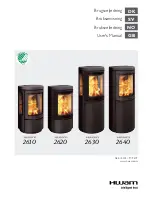
3
rating in the same room as the
stove can weaken the chimney
draught, which can effect the
stove’s efficiency. It can also lead
to smoke escaping into the room
when opening the firing door
4. Do not cover the air vents, if fitted.
Floor surface
Ensure the floor can bear the weight
of the stove and top-mounted steel
chimney, if applicable. The stove
must stand on a non-flammable sur-
face such as steel plate or brick/tile.
The dimensions of the non-flamma-
ble surface used to cover the floor
area must comply with applicable
regulations for your particular area
or country.
Chimney connection
The chimney opening must comply
with national and local regulations.
However, the area of the opening
should not be less than 175 cm2,
which corresponds to a diameter of
150 mm. If a damper is fitted to the
flue gas pipe, there must be at least
20 cm2 of free passage when in the
closed position. If local regulations
permit, two closed fireplaces may
be connected to the same chimney.
However, you must be aware of local
regulations regarding how closely
they may be located to each other.
Stoves must never be connected to a
chimney that already has a gas-fired
heater connected to it.
An efficient stove places high de-
mands on a chimney. Therefore, al-
ways have your local chimney sweep
assess the condition of your chimney
Connecting to a brick chimney
Build a thimble into the chimney
to accommodate the flue gas pipe.
The thimble and flue gas pipe must
not penetrate the chimney opening
itself, but must be flush with the in-
side of the chimney duct. The points
where brickwork, thimble and flue
gas pipe meet must be sealed with
fireproof material/beading.
Connecting to a steel chimney
When connecting a top-outlet stove
directly to a steel chimney, we re-
commend feeding the chimney pipe
inside the connecting pipe from the
stove, which will allow soot and
condensation to drop into the stove
itself rather than collecting on the
outside surface.
An installation must comply with ap-
plicable national and local regulati-
ons where a chimney is fed through
an internal ceiling. To avoid overloa-
ding the stove, it is important that
the chimney is supported by a load-
bearing roof support.
Draught conditions
Poor draught may result in smoke
escaping from the stove when the
door is opened.
To ensure satisfactory combustion,
chimney draught for this oven should
be at least 10 PA, although some
smoke may still escape if the firing
door is opened when the stove is
burning strongly.
The nominal flue gas operating tem-
perature is 236°C with an outdoor
temperature of 20°C.
The flue gas mass flow is 14.7 g/sec.
Chimney draught is generated by
the difference between the high
chimney temperature and low out-
door temperature.
The chimney’s length and insulation




































